Cosy holiday home rentals in Sète, France
Le Pouffre and Le Piade***
Climb Mont Saint Clair in Sète
The Mont Saint Clair panoramic view
Dominating the Mediterranean at a height of 175 meters at sea level, Mont Saint-Clair is an ancient volcano which gives a very particular silhouette to the city of Sète. From its summit, a magnificent panorama overlooks the canals and its port, the Richelieu citadel, the lighthouse and the famous marine cemetery where Paul Valéry, the French writer, poet and philosopher has been buried since 1945.
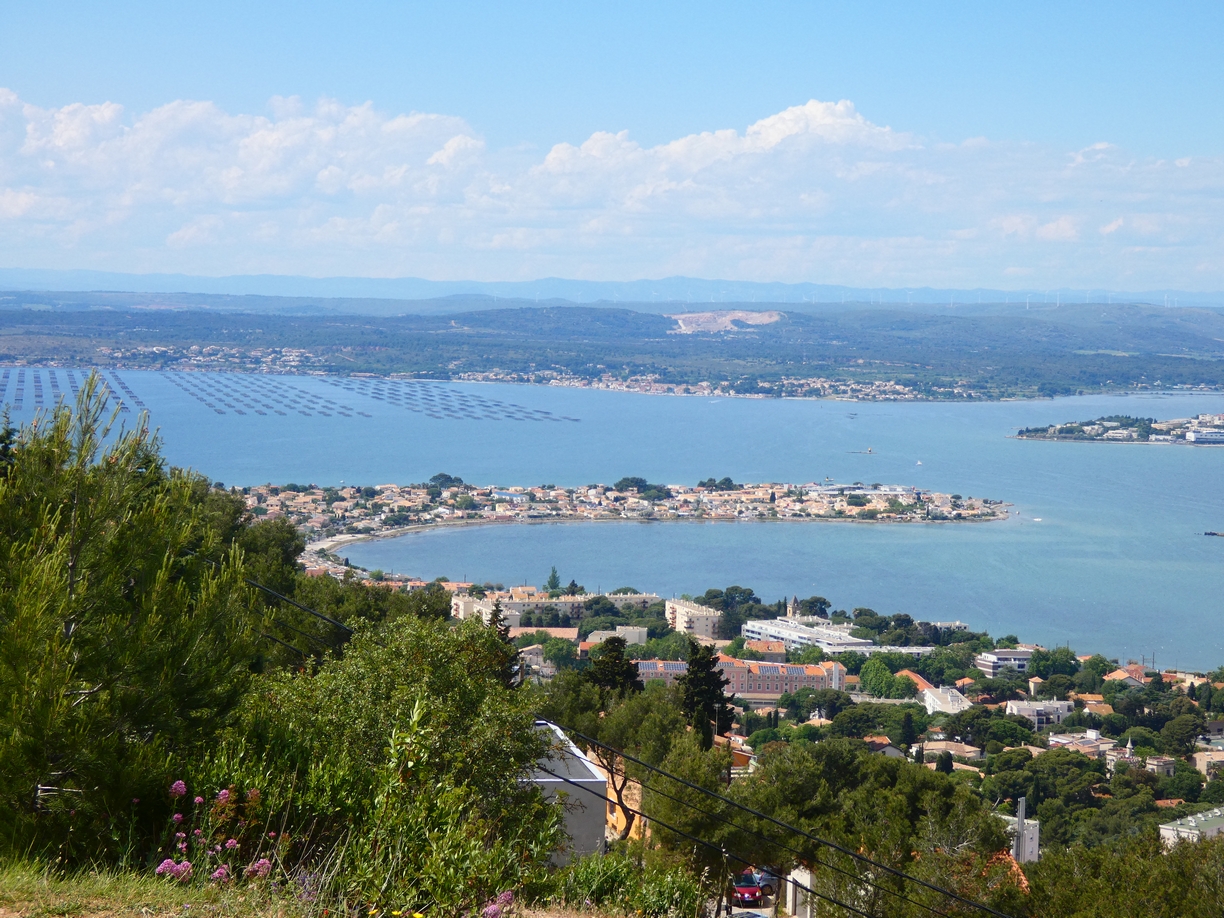
The Thau lagoon and the Le Barrau district
On the other side are the Thau lagoon with its oyster beds and the Gardiole massif and in the background the Canigou, the Eastern Pyrenees at their most beautiful. An impressive view of the sandy coastal strip, which separates the blue sea from the Thau lagoon, awaits you.
The belvedere offers a strategic point of view to discover Sète so special. Built around its ports, crossed by canals which provide passage between the sea and the Thau lagoon, the city is connected by nine bridges which are to be discovered. Sète well deserves its nickname of singular island or little Languedoc Venice.
Explore the little paths of Mont Saint-Clair on foot and stroll around the traditional villas from the beginning of the 19th century, while enjoying breathtaking views at every turn!
The climb: walking route
How long does it take to climb Mont Saint-Clair? With its 225 steps (easy to climb and wide) await you to enjoy a 360 degree landscape with a view of the Mediterranean, the port, the Thau lagoon and the coastal strip with its vineyards and beaches in approximately 20-25 minutes. A word of advice: in summer, avoid the heat and preferably walk early in the morning or late in the afternoon. At sunrise or sunset, the view is always splendid.

Panoramic view of Mont St Clair from our holiday apartment Le Piade
From Pouffre, our holiday home in Sète, turn right onto Grande Rue Haute. Go straight, turn left onto rue Garenne then immediately left onto Rue de Villefranche. Continue on Rue Louis Ramond which becomes Rue Belfort. Turn left onto Impasse des Lauriers then turn left onto Chemin de Biscan Pas to take the steps and reach the summit. Climb time: 19 mins, 1.1 km.
Du Piade, notre appartement de vacances à Sète, empruntez la Rue de La Revolution, tournez à droite sur Rue du Maire Aussenac, puis tournez à gauche sur Rue de la Caraussanne, tournez à droit sur Rue Louis Ramond qui devient Rue Belfort. Tournez à gauche sur Impasse des Lauriers puis tournez à gauche sur Chemin de Biscan Pas pour emprunter une belle volée de marches et rejoindre le sommet. Temps de la montée : 27 mn, 1.7 km.
Arrivé au sommet, la récompense est au bout de l’effort. Au pied de la Croix Saint-Clair, le belvédère offre une vue plongeante et saisissante sur Sète, le port, la mer ainsi que sur la côte Languedocienne. Elle était inaugurée en le 19 février 1983 et remplace celle détruite par la violente tempête de 1982.
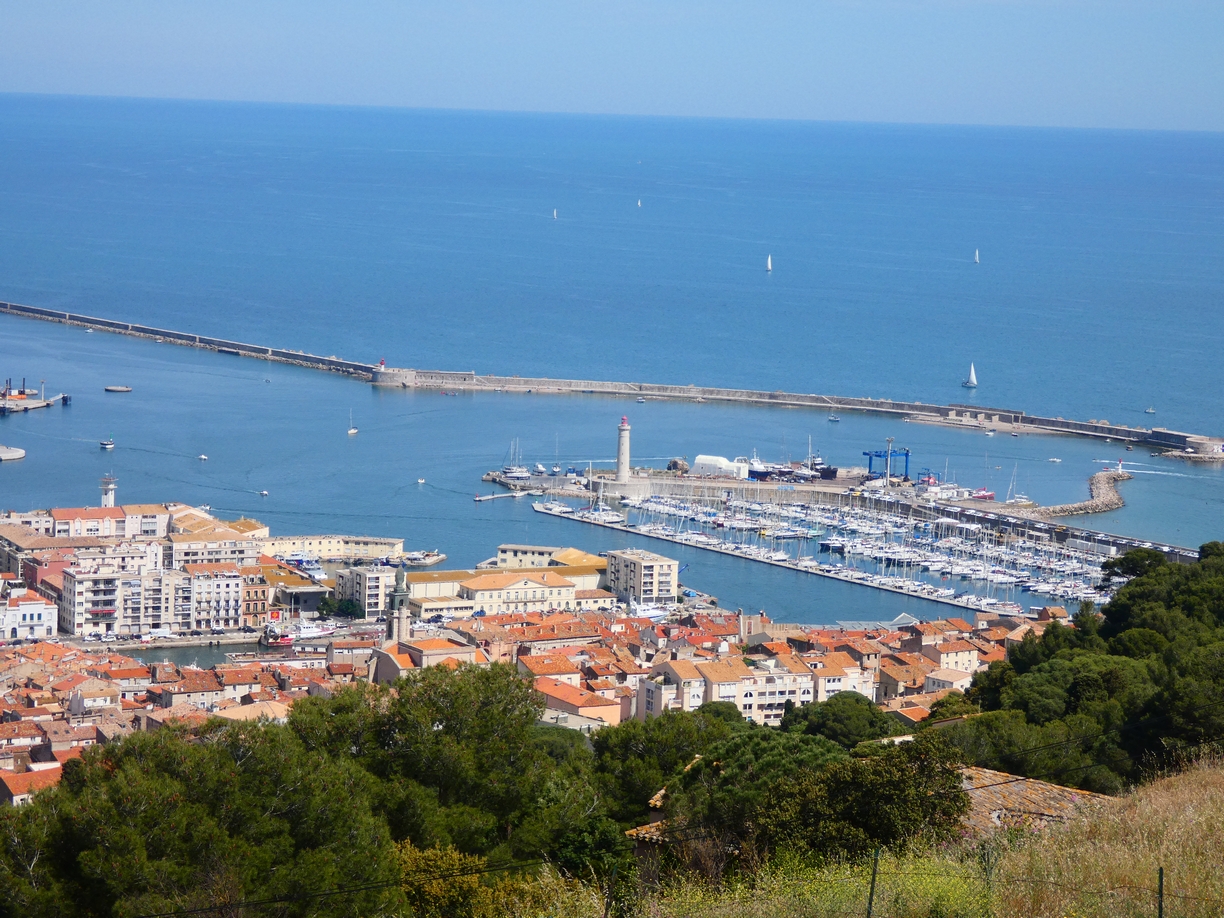
View from Mont St Clair over the town of Sète and the Languedoc coastline
The Mont Saint Clair cross
Mont Saint Clair bears a cross at its summit. It embraces the town, and is to Sète what the Christ the Redeemer on Corcovado is to Rio, or what the Statue of Liberty is to New York. It is lit up at nightfall, all year round.

The Sète Cross on Mont Saint Clair
The luminous cross perpetuates the fire that the people of Sète lit on 12 July 1932 to celebrate the saint who gave his name to the mountain. A marble plaque on the back of the cross, nestling in the base, bears the words: ‘From the top of the Cross Jesus looked down on the town. Standing at his feet, Mary wept. May the Cross guard those who raised it’. A stele donated by the Algerian teachers killed during the war of independence was unveiled next to this cross in 1990.
The Notre-Dame-de-la-Salette chapel
At the summit is the Notre-Dame-de-la-Salette chapel, where masses are regularly celebrated. This chapel is dedicated to the Virgin Mary, who appeared on 19 September 1846 to two children from the village of La Salette-Fallavaux in Isère. In 1864, Henri Gaffino, dean priest of Sète and its ports, dedicated the chapel at the summit of Mont Saint Clair (evangeliser of the region) to Notre Dame de la Salette.
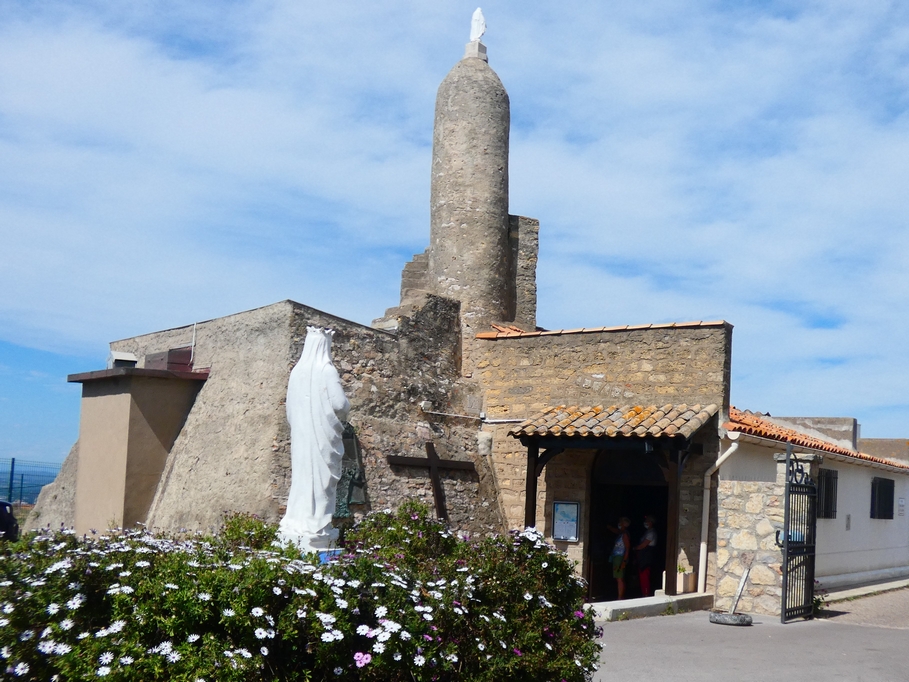
Notre Dame de la Salette Chapel in Sète
In 1861, the chapel was rebuilt on the remains of sections of military walls, which goes some way to explaining its severe appearance. From the outside, the chapel looks more like a fort than a place of worship, because before the town of Sète was founded, Duke Henri 1st de Montmorency, governor of Languedoc, had a fort built on the site of an ancient Roman ford after driving the pirates off the island.
The statue of the Virgin was erected in 1866 to commemorate the town’s bicentenary. Its bell tower also served as a geodesic marker.
This chapel is a traditional place of pilgrimage. Mass is celebrated here every 19th of the month.
As you push open the door, you will surely marvel at the frescoes by the painter Bringuier (1951-1953) that cover the entire building. The part of the chapel dedicated to Sainte Rita and Notre Dame de la Chapelle is also covered with ex-votos (offerings made to God in request of a grace or in thanksgiving). A visit to the Notre-Dame-de-la-Salette chapel that will leave you breathless!
The Pierres Blanches national forest
From the Pierres Blanches state-owned forest, you can see the Thau lagoon and its oyster beds. Take the Chemin des Pierres Blanches on the right and 1.5km (15-minute walk) away, at the other end of the hill, the state-owned Pierres Blanches forest is ideal for walkers.
The Pierres Blanches state-owned forest, with its 27 hectares of pine forest, offers numerous footpaths with extraordinary views over the Mediterranean. The panoramic view of the lido running between the sea and the lagoon from the lookout point and orientation table is breathtaking.
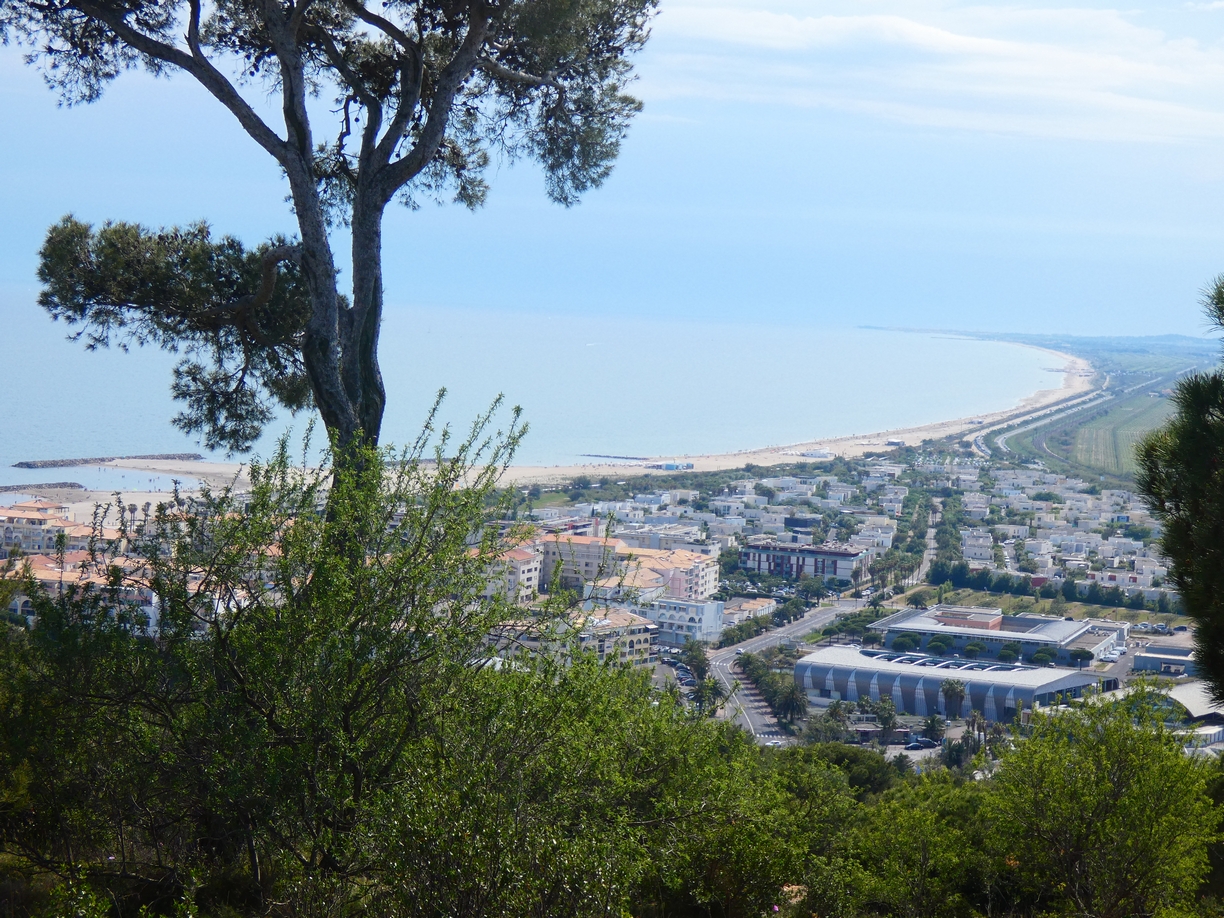
Panoramic view from the Pierres Blanches forest over the beaches from Sète to Marseillan
Numerous signposted footpaths have been laid out, scented with pine and thyme. There are educational panels to help you discover the 400 or so species of plants that live here, including some forty species that are not very common. There are also special areas where visitors can take a welcome break.
Walk, picnic or take a break in the Pierres Blanches forest
Before it became Sète’s state forest, this land was used as a gardening and grazing area for the farming families (sheep, goats, cows) who lived in the stone houses known as ‘baraquettes’. During the Second World War, the trees on Mont Saint-Clair, particularly the holm oaks, were used by the people of Sète for heating. The German occupying forces used the site to keep an eye on any landings.
In 1972, faced with the threat of urbanisation, it became a ‘state forest’ managed by the Office National des Forêts (National Forestry Office) to guarantee its long-term vocation as a natural area. Today, the ONF and the commune of Sète are investing in the site to: – offer the public a welcoming space; – maintain the diversity of the landscapes and natural environments; – guarantee the long-term future of the forest.
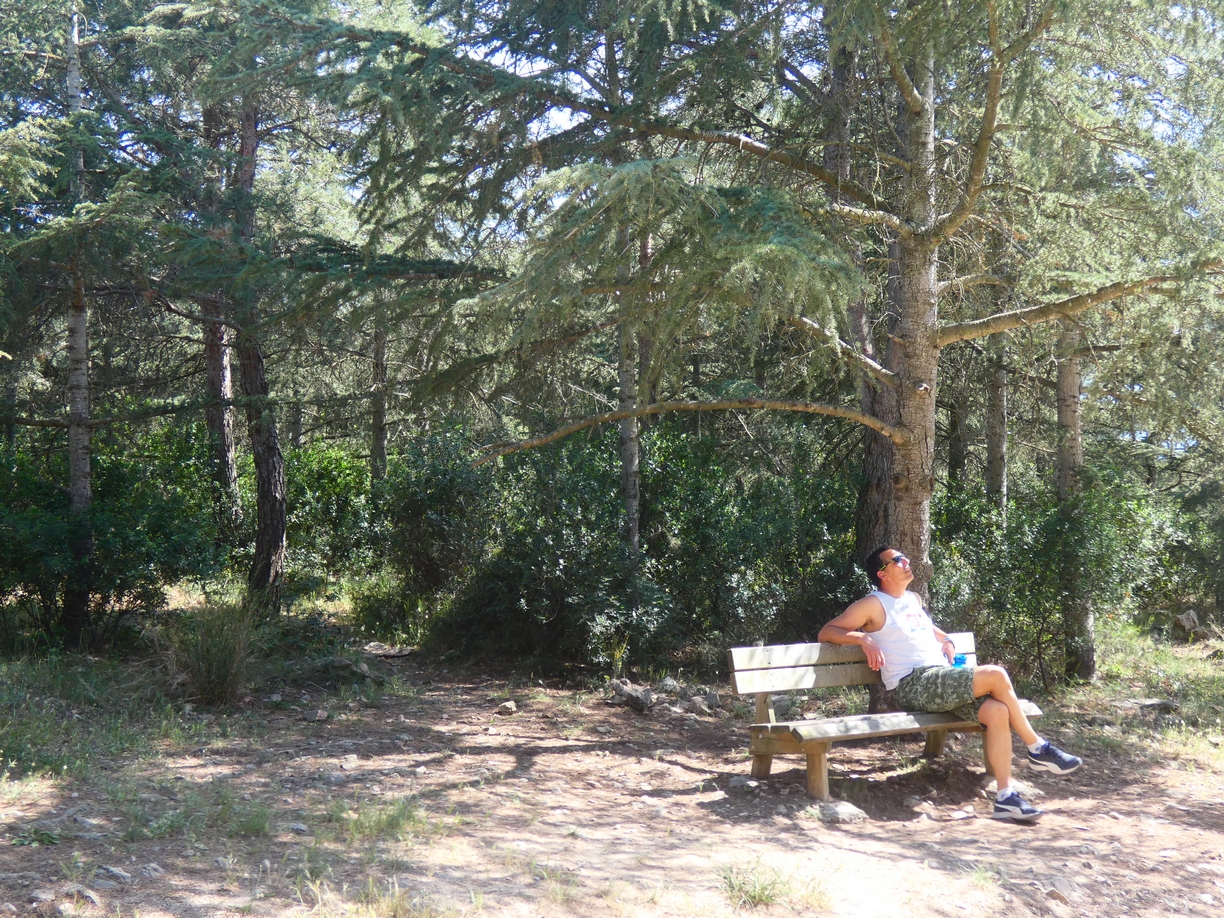
The trails in the Pierres Blanches forest
The descent
Before descending, you can grab a bite to eat or a drink at Le Safari grill restaurant. To get off, you can retrace your steps or take the line 5 bus down to Pouffre or the town centre.
The more adventurous can take advantage of the return journey to go for a swim at the Corniche beach (20 mins walk; 1.6 km) and then take the return bus line 7 to the Ifremer stop and get off at the Commissariat stop for our Le Piade holiday flat. Alternatively, take line 5 to the Notre-Dame Souveraine du Monde stop and get off at the Cimetière Marin stop to return to our Le Pouffre holiday home.
Take the bus up Mont Saint Clair
If you don’t want to walk up Mont Saint Clair, take line no. 5 to the Cimetière Marin stop from our Le Pouffre home or from the Promenade J. Baptiste Marty in the town centre.
Enjoy your visit!
